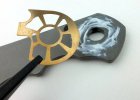- Joined
- Apr 5, 2024
- Messages
- 93
Based on my limited understanding, a bushing allows the pivot pin to "lock" onto the interior of the bushing, and the higher-tolerance outside of the bushing can glide against a higher tolerance hole in the blade. A washer seems like it might do the same thing, but with more surface area - thus - more friction. Surely, I misunderstand? Maybe we want more friction in some cases?

